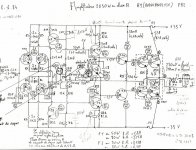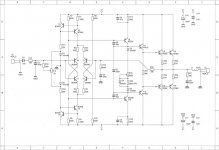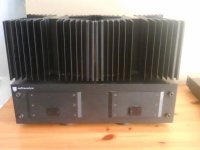hi,
Audio Analysé is a French company from the 80 - who knows some thing about this amp?
i think that today is metronome-technology, but there is no trace back to it.
it has a very good sound, i am looking for the schematics of the power amp!
best regards,
Williams
Audio Analysé is a French company from the 80 - who knows some thing about this amp?
i think that today is metronome-technology, but there is no trace back to it.
it has a very good sound, i am looking for the schematics of the power amp!
best regards,
Williams
Hi,
This is the only schematics I have.
Audio Analyse amps were class A. Famed in France for excellent sound but very unreliable. Some people incriminate insufficient cooling, I think there could be a thermal cycling problem. If you own one, I suggest you find a way to decrease the power supply voltage.
This is the only schematics I have.
Audio Analyse amps were class A. Famed in France for excellent sound but very unreliable. Some people incriminate insufficient cooling, I think there could be a thermal cycling problem. If you own one, I suggest you find a way to decrease the power supply voltage.
Attachments
hi forr,
thanks a lot, this amp is very, very hot i think to add some forced ventilation
best regards,
Williams
thanks a lot, this amp is very, very hot i think to add some forced ventilation
best regards,
Williams
kinda strange thing on the schematic..
the negative feedback is took after the output protection
fuse...if this one blow, the amp will be forced into open loop
configuration..
the negative feedback is took after the output protection
fuse...if this one blow, the amp will be forced into open loop
configuration..
...which probably wont do much harm, since the output then is unloaded.kinda strange thing on the schematic..
the negative feedback is took after the output protection
fuse...if this one blow, the amp will be forced into open loop
configuration..
And the reason for doing so is ofcourse to remove the sonic influence of the fuse.
...which probably wont do much harm, since the output then is unloaded.
And the reason for doing so is ofcourse to remove the sonic influence of the fuse.
yes, although i woudn t waste negative feedback to correct
a fuse nonlinarity...a relay would be a far better solution, moreover as
this is supposedly an audiophile oriented item...
Add a resistor of a few hundreds Ohm and enough wattage across the fuse. In case of blown fuse, the feedback loop is maintained, the blown open fuse closed loop gain then having just a little bit more value than the passing fuse closed loop.
Add a resistor of a few hundreds Ohm and enough wattage across the fuse. In case of blown fuse, the feedback loop is maintained, the blown open fuse closed loop gain then having just a little bit more value than the passing fuse closed loop.
...but on the other side of it there is 4-8ohm to ground = circuit is still open looped.
The A9 does 60W in Class AB, 50W brochure spec.(Biggy A90 goes 120W, 50 in full Class A)
90W of heat on 160VA toroids in the A9 is pushing it, even if biased only to 25W continuous.
Schematic of the B90/P90 power amp section, 10W Class A and 100 in AB=>
90W of heat on 160VA toroids in the A9 is pushing it, even if biased only to 25W continuous.
Schematic of the B90/P90 power amp section, 10W Class A and 100 in AB=>
Attachments
Last edited:
Hi all,
Who owns such amps, how is the sound of it?
nirik, is correct if the fuse is gone and there is no load, the loop is open and the amp will run to a extreme working point.
The schematic sent by "forr" A9, what is exactly A90, B__? i didn't know there are few amps, A9 looks very popular design, a bit like the "mark levinson" at the beginning.
by the way i didn't get the amp from the guy that wonted to sell it, he sent it to be repair abroad.
Jacco, thanks for the info, did you simulate the B90 amp sent by you? Looks like a spice drawing.
Best regards,
Williams
Who owns such amps, how is the sound of it?
nirik, is correct if the fuse is gone and there is no load, the loop is open and the amp will run to a extreme working point.
The schematic sent by "forr" A9, what is exactly A90, B__? i didn't know there are few amps, A9 looks very popular design, a bit like the "mark levinson" at the beginning.
by the way i didn't get the amp from the guy that wonted to sell it, he sent it to be repair abroad.
Jacco, thanks for the info, did you simulate the B90 amp sent by you? Looks like a spice drawing.
Best regards,
Williams
...which probably wont do much harm, since the output then is unloaded.
And the reason for doing so is ofcourse to remove the sonic influence of the fuse.
NF used to 'correct' for the sonic influence of a fuse.....


No wonder NF gets a bad rep.
 .....
.....
...but on the other side of it there is 4-8ohm to ground = circuit is still open looped.
On the other side, it can even be 0 Ohm, which may be a good reason why the fuse has blown.
I see what you mean, I'm plain wrong.
For an amp with an output fuse included in the negative feedback loop, what it need is to limit the fed back to avoid the voltage gain stages to enter in saturation, maybe with be some diodes.
The DB6 amplifier had such a scheme. What puzzled me was that, when removing the fuse, a LED lighted.
I once had an integrated version - I think it was called B90. The looks were stunning with the huge heatsinks on the sides. The sound was warm and musical, with good bass and mids, but the highs were a bit on the dull side.
For people who prefer 'musical' sound like tubes, these amplifiers are well worth a listen, but I prefer a more analytic/detailed sound so I sold it.
For people who prefer 'musical' sound like tubes, these amplifiers are well worth a listen, but I prefer a more analytic/detailed sound so I sold it.
hi Nrik,
thanks for the info, at the moment this amp is gone, so i can't do a lot about it
i got right away a odyssey audio pre+pwr,they are very good
best regards,
Williams
thanks for the info, at the moment this amp is gone, so i can't do a lot about it
i got right away a odyssey audio pre+pwr,they are very good
best regards,
Williams
didn't know there are few amps
A few brands even.
When Audioanalyse went bust in the late 80s, the importer of AA and other French brands overhere continued production under the Duson brand name. (sounds somewhat Chinese currently)
The top model power amp A90 has been solely AA manufacture, the split-level maisonette design was remarkable enough at the time to be on display at the NY museum of modern art for several years.
The A90 is twice of everything of the A9 ; 8 Motorola TO3s per channel instead of 4, 330VA toroids instead of 160VA, close to 100K uF/ch PS lytics instead of 47K uF.
Same story as the A9 otherwise as well, unable to run Full Class A as heatsinks and transformers can't cope with +250W continuous dissipation from 50Vdc rails.
Good examples of the blurry definitions of Class A, one is that dissipation of a Class A amp equals power output.
Strictly speaking, the AA power amps were entitled to be labelled as Class A by that definition at the time, very high bias Class AB would be more appropiate nowadays.
Obviously, the Audio Analyse designer got his inspiration from early Krell KSA models : 2/3d of a Krell in all, close to $3K for the A9 and $6K for the A90, with exception of the smashing industrial exterior design.
Innards were rather dissapointing, even in the 80s, plenty of competitors then with a cleaner layout.
Example for the A9 : ground wire/traces were dimensioned too thin, leading to ground not at zero potential at higher output levels.
Attachments
Last edited:
Hi,
This is the only schematics I have.
Audio Analyse amps were class A. Famed in France for excellent sound but very unreliable. Some people incriminate insufficient cooling, I think there could be a thermal cycling problem. If you own one, I suggest you find a way to decrease the power supply voltage.
Funny how much this one looks like a GAS Son of Ampzilla. The latter is better built but not Class A. Can be crancked up though....
I used to have an Audioanalyse A9, something like 15 years ago.
It used to drive some panel speakers I had then and I remembered that it sounded really good and produced a lot of heat. However one day one channel went bad and never used it again, until it made a really nice house for an F5 I use now, as you can see in the photo!
Transformers were really small. I use them now for my phono pre!
It used to drive some panel speakers I had then and I remembered that it sounded really good and produced a lot of heat. However one day one channel went bad and never used it again, until it made a really nice house for an F5 I use now, as you can see in the photo!
Transformers were really small. I use them now for my phono pre!
Attachments
QSerraTico_Tico,
You beat me to it, I was thinking the same thing when I saw those schematics. I knew it looked familiar so I dug up my SON schematic and sure enough almost the same. Might even try to build one, already have most of the parts except the big *** heatsinks!
Craig
You beat me to it, I was thinking the same thing when I saw those schematics. I knew it looked familiar so I dug up my SON schematic and sure enough almost the same. Might even try to build one, already have most of the parts except the big *** heatsinks!
Craig
- Home
- Amplifiers
- Solid State
- audio analyse' - French made amp?



